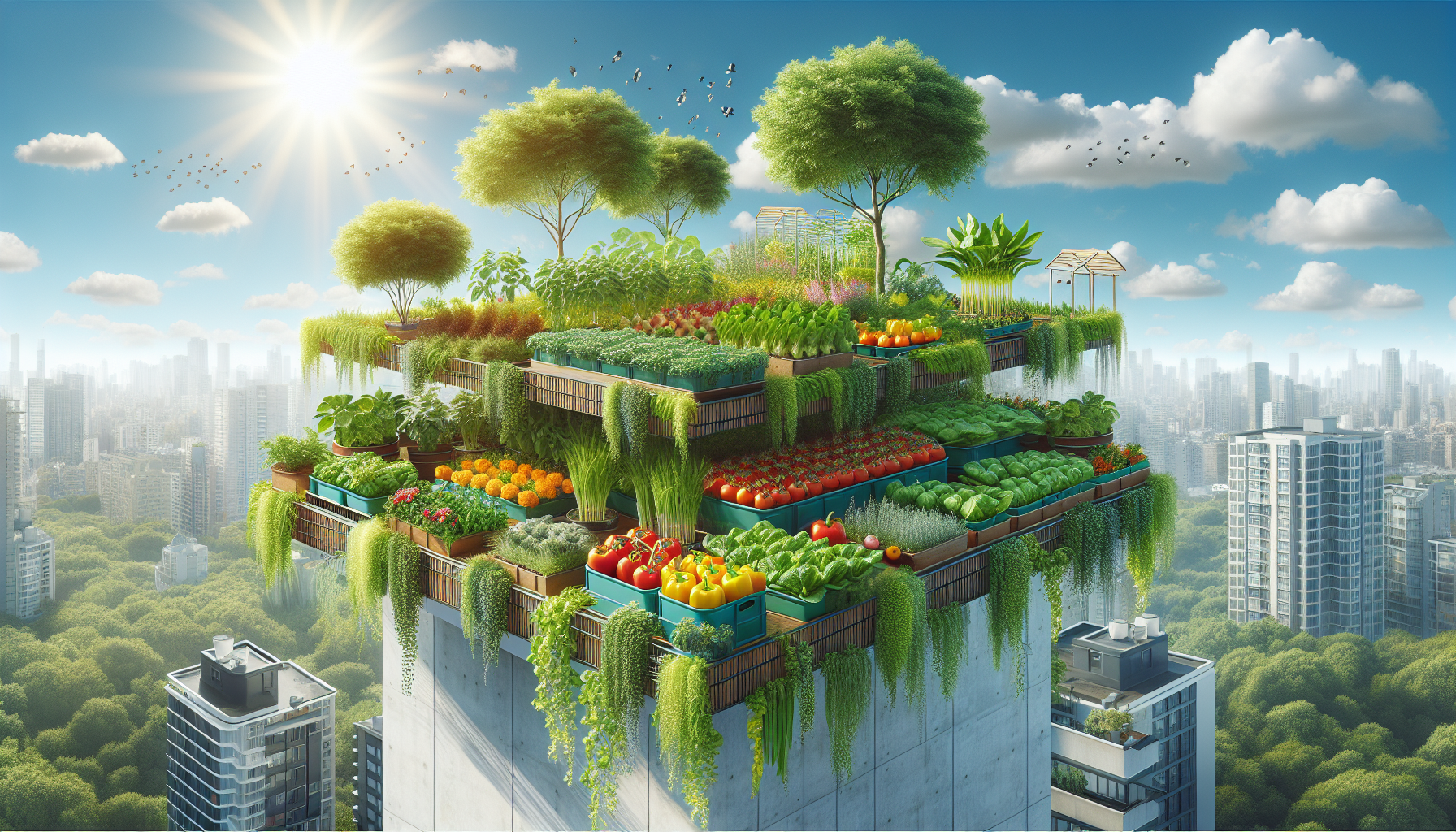Your cart is currently empty!
Top Tips for Thriving Urban Gardening
Top Tips for Thriving Urban Gardening: Maximize Your City Space
Maximizing limited outdoor space is a challenge for urban dwellers eager to garden. Urban gardening offers solutions to grow your own food and beautify your home regardless of space constraints. This article offers clear, actionable advice on how to create a flourishing garden in the smallest of city spaces, helping you reap the benefits of greenery right where you live.
Key Takeaways
- Urban agriculture is a comprehensive movement in city living, essential for sustainability, social well-being, and food accessibility, incorporating various innovative gardening methods like rooftop, balcony, and vertical gardening.
- Urban gardening thrives despite limited space through creative solutions, uses local climate knowledge to choose suitable plants, and applies sustainable practices like water conservation and integrated pest management.
- Urban garden communities enhance social connection, sharing experiences and tips can be done through local groups or online platforms, and budget-friendly gardening is achievable through DIY, repurposing, and seed saving.
Embracing Urban Agriculture: The Basics

Urban agriculture isn’t just a trend; it’s a revolution in our cityscapes. It extends beyond growing food to encompass community development, public health, and education. By bringing crops and plants into the heart of our cities, urban gardeners are reimagining what it means to live sustainably within our urban ecosystems.
Whether you’ve just started your green journey or you’re looking to expand and extend your knowledge, urban agriculture offers a fulfilling path for anyone eager to dip their hands into the soil of possibility.
Defining Urban Agriculture
What exactly is urban agriculture? It’s the art of cultivating, processing, and distributing food in urban and peri-urban areas, integrating into the very fabric of urban food systems. This goes beyond just garden beds and potted plants; it includes a range of food-related activities from commercial endeavors to educational pursuits.
Urban farming is particularly innovative, using techniques that overcome the spatial challenges of city living to bring fresh, locally-grown food to our tables, making a positive impact in the world.
Why Urban Agriculture Matters
Why is urban agriculture so important? It’s about more than just fresh tomatoes and fragrant basil. Urban gardens beautify our neighborhoods, contribute to our social well-being, and even improve environmental health. However, like any agricultural practice, it’s not without its large carbon footprint, which is why sustainable practices and careful crop selection are crucial.
Many urban gardeners choose herbs and medicinal plants, not only for their small-scale suitability but also to meet the demand for fresh produce.
Types of Urban Gardens
Urban gardens come in as many shapes and sizes as the cities they inhabit. Some examples include:
- Rooftop sanctuaries
- Vertical farms
- Community gardens
- Balcony gardens
- Window box gardens
These gardens introduce innovative methods like hydroponics and aquaponics to city living.
There are also community gardens, which turn unused lots into shared spaces for cultivation. And it’s not just about plants; urban agriculture can also include beekeeping, poultry, and edible landscaping.
Creating Your Own Urban Garden: Space Utilization Ideas

Limited space in the city? No problem! Urban gardening is all about creativity and making the most of what you have. Whether you’re working with a sprawling rooftop or a cozy balcony, there are countless ways to create a lush garden that fits your urban environment.
Explore these space-efficient strategies that enable you to grow food and plants in the most unexpected urban spaces.
Rooftop Gardening

Rooftop gardens are the crown jewels of urban agriculture. They’re not only a source of fresh produce but also a recreational space that contributes to:
- Building insulation
- Battling against urban heat islands
- Conserving water
- Improving air quality
- Adding a touch of biodiversity to the urban landscape
Imagine a rooftop with a mix of flowers, shrubbery, and water features – it’s a true testament to the potential of urban spaces.
Balcony Gardening
Don’t underestimate the power of a balcony garden. With a little ingenuity, these small spaces can yield a surprising amount of food and beauty. By adapting garden designs to local weather conditions, you can create a verdant retreat that thrives in the face of urban challenges.
Start seeds in repurposed containers like yogurt pots or egg cartons, and you’ll soon understand why balcony gardeners are so proud of their pint-sized plots.
Vertical Gardening
Vertical gardening is a game-changer for urban gardeners, allowing you to grow up when you can’t grow out. Utilize every inch of your space with wall-mounted pots, trellises, and hanging planters. Not only does this method increase your yield by occupying less ground, but it also promotes healthier plants with better air flow and sunlight exposure.
Plus, with a bit of DIY spirit, you can upcycle items like plastic bottles into cost-effective vertical gardens.
Climate Considerations for Urban Gardeners

Gardening in the city means getting up close and personal with the local climate. Each urban environment has its unique weather patterns, and understanding these can be the difference between a thriving garden and a wilting one.
Discover how to leverage the advantage of your city’s unique climate to bolster your urban garden.
Understanding Your City’s Climate
To create a thriving urban garden, you must first understand your city’s climate and growing season. Plant hardiness zones have been shifting, and urban gardeners need to adapt their planning accordingly. These zones, based on average annual minimum temperatures, are crucial for choosing the right plants.
In places like Apúlia, Portugal, adapting to the local climate has improved biodiversity and garden resilience. Remember, the choice of plants should also reflect your personal preferences and economic factors.
Selecting Climate-Resilient Plants
Incorporating climate-resilient plants into your urban garden can lead to environmental benefits like soil rehabilitation and increased biodiversity. These plants can adapt to a wider temperature range, which is becoming increasingly important as minimum temperatures rise.
When planning your garden, observe past plant growth patterns to inform your future selections.
Adapting to Changing Weather Conditions
Adapting to changing weather conditions is key for urban gardeners. Here are some strategies to consider:
- Use privacy screens as windbreaks for balcony plants
- Implement wastewater recycling as a sustainable water management practice
- Select plants suitable for a wider temperature range as climate change progresses
Additionally, indoor hydroponic farming environments offer controlled conditions that allow for consistent production regardless of weather changes.
Soil and Growing Medium Options for Urban Gardens
Whether you’re growing juicy tomatoes or fragrant herbs, the right soil or growing medium is crucial. Urban gardeners have a variety of options at their fingertips, each offering distinct benefits for plants.
Investigate the various mediums that can enhance your urban garden’s productivity.
Organic Soil Mixes
Organic soil mixes are specially crafted to promote healthy plant growth in urban gardens. These mixes often contain compost and rice hulls, providing excellent conditions for a wide range of plants.
Incorporating ‘black gold,’ or finished compost, into your potting soil will enrich it with essential nutrients.
Hydroponic Systems
Hydroponic systems are a soil-less wonder, allowing urban gardeners to:
- Stack crops vertically and save space
- Grow plants indoors all year round
- Control the nutrient levels for optimal plant growth
- Avoid soil-borne diseases and pests
- Use up to 90% less water than traditional methods
These systems are not only space-efficient but also water-efficient.
Alternative Growing Mediums
Urban gardeners also have a variety of alternative growing mediums at their disposal. Some options include:
- Perlite
- Vermiculite
- Coconut coir
- Expanded clay pellets
- Pine bark
These mediums provide excellent aeration and water retention, in addition to making them suitable for hydroponic systems. They also have a neutral pH and the ability to hold nutrients.
Sustainable Urban Gardening Practices

Sustainability is the heart of urban gardening, ensuring that our green spaces are not only beautiful but also beneficial to the environment. From water conservation to pest management, there are numerous practices that can make your urban garden a model of eco-friendliness.
Water Conservation Techniques
Water is a precious resource, and conserving it is a priority area for urban gardeners. Techniques like rainwater harvesting and efficient irrigation systems can significantly reduce dependency on municipal water supplies.
Applying compost and using mulch can help soil retain water, reducing the need for frequent watering.
Integrated Pest Management
Integrated Pest Management (IPM) is an environmentally friendly approach to controlling pests. It uses a combination of methods like:
- biological controls
- resistant plant varieties
- cultural practices
- physical barriers
- chemical controls (as a last resort)
To maintain ecological balance, it’s important to take into account the various factors that contribute to a healthy environment, such as the appropriate management of log resources.
Companion planting and efficient watering practices also play a role in sustainable pest management.
Composting and Recycling
Composting turns organic waste into a valuable resource for urban gardens. By maintaining the right balance of materials and regularly turning the compost pile, urban gardeners can create a nutrient-rich soil amendment process.
Recycling water using filtration systems is another sustainable practice that benefits urban gardens.
Growing Food for Your Family: Vegetables, Herbs, and More
One of the greatest joys of urban gardening is the ability to grow your own food, right where you live. Whether it’s a container garden on a patio or a vertical setup on a balcony, there are plenty of options for cultivating delicious and nutritious vegetables, herbs, and more for your family.
Easy-to-Grow Vegetables for City Spaces
Vegetables like chard, lettuce, and cherry tomatoes are perfect for container gardening in urban spaces. Dwarf or bush varieties are especially suited for small spaces, maximizing yield.
Lettuce, radishes, and spinach are among the easiest vegetables to grow in an urban setting.
Fresh Herbs for Your Kitchen
Herbs such as basil, parsley, and rosemary are ideal for urban kitchen gardens due to their adaptability and the fresh flavors they bring to home-cooked meals. These herbs can be grown indoors, ensuring a year-round supply of fresh greenery.
Edible Flowers and Unusual Crops
Edible flowers like nasturtiums and calendula add visual appeal and unique flavors to urban gardens. These flowers are well-suited for container gardening and shade well, making them a great choice for city dwellers looking to brighten up their space with both beauty and taste.
Building Community through Urban Gardening
Urban gardening is more than just a personal endeavor; it’s a powerful way to build community. Through shared gardens, workshops, and social media, urban gardeners can come together to learn, grow, and support one another.
Joining Local Gardening Groups
Joining a local gardening group is a great way to connect with friends and fellow garden enthusiasts. These groups provide a platform for sharing knowledge and networking, which can be especially helpful for newcomers.
Activities like meetings and community service projects offer opportunities to get involved and learn more about urban gardening.
Participating in Community Gardens
Community gardens offer a space where families, neighbors, and individuals of diverse backgrounds can come together to garden and bond. Volunteering in these gardens not only contributes to the local community but can also have global impacts.
These gardens often use containers and raised beds to maximize space and foster engagement.
Sharing Your Urban Gardening Journey on Social Media
Sharing your urban gardening journey on platforms like Facebook can connect you with a global community of gardeners. Online communities offer flexibility, allowing you to set up to engage with others according to your schedule. Platforms also provide access to shared resources and in-person events like garden tours and workshops.
Budget-Friendly Urban Gardening Tips
Urban gardening can be economical with some inventiveness and resourcefulness. You can initiate and sustain a lush garden within a budget. Explore these cost-efficient methods to cultivate your garden without straining your finances.
DIY Garden Projects
Embrace the satisfaction of a do-it-yourself approach with garden projects that can significantly cut costs. Building your own planters or creating garden spaces with upcycled materials adds a personal touch to your urban oasis. Not only does it save money, but it also allows you to tailor your gardening space to your specific needs, whether you’re crafting a living wall for herbs or a bean teepee for climbing plants.
Repurposing Household Items
Before you toss out that old furniture or those empty containers, consider how they could be given a new life in your urban garden. Converting items like kiddie pools or colanders into planting containers is not just a cost-saving measure; it’s a creative way to bring a unique charm to your garden space.
Repurposed take-out containers can be perfect for starting seeds or serving as reservoirs in window farms, merging practicality with ingenuity.
Saving Seeds and Propagating Plants
One of the most budget-friendly gardening practices is saving seeds from your plants. By collecting seeds from favorites like tomatoes or peppers, you can ensure a continuous supply of crops without additional cost. Open-pollinated varieties are ideal for seed saving as they produce offspring true to the parent plant.
Properly stored, these seeds can remain viable for the next season, contributing to the sustainability and cost-efficiency of your urban garden.
Summary
We’ve journeyed through the concrete and the compost, exploring the ins and outs of urban gardening. From the basics of starting your garden to the finer points of climate and community, the path to a successful urban oasis is clear. Embrace the lessons of space utilization, sustainability, and budget-friendly practices, and watch as your urban garden becomes a source of pride, produce, love and peace.
Frequently Asked Questions
What is the difference between urban farming and gardening?
Urban farming often involves larger-scale production of food for sale and requires a business license, while gardening is typically done on a smaller scale for personal consumption or limited nonprofit sales. Both activities engage stakeholders, but urban farming is more commercial in nature.
What is urban agriculture?
Urban agriculture is the practice of growing, processing, and distributing food within city areas, including commercial, personal, and educational activities using innovative techniques to address space limitations.
Can you really grow food in a small balcony space?
Yes, you can definitely grow food in a small balcony space. With the right containers and plant choices, even a small balcony can produce a bounty of herbs, vegetables, and flowers.
How important is understanding my city’s climate for gardening?
Understanding your city’s climate is crucial for successful gardening. It will help you select the appropriate plants and adjust your gardening methods for optimal growth.
Are there sustainable practices for urban gardening?
Absolutely! Implementing practices like water conservation, integrated pest management, and composting can help create a sustainable and healthy urban garden.